3 The structure and economy of the video game industry in Norway
3.1 Introduction
In this chapter, the Ministry gives a presentation of the video game industry. This is done by briefly describing the general characteristics of the video game market and then providing an account of the stages of the value chain. In connection with the value chain, the Ministry will provide a description of the structure of the Norwegian industry.
3.2 General characteristics of the video game market
Although the video game industry is relatively young, competition is keen. The success of industry stakeholders is dependent on a number of factors, and these vary somewhat between the various markets. National success factors, for example, differ somewhat from international success factors. In the following, the Ministry discuss some of the most central success factors for Norwegian game developers.
The quality of the game is of decisive importance. The game must have a good story, be fun to play (playability) and be well crafted as regards graphics, sound and music. The balance between good graphics and story/playability varies considerably. An increasing number of games focus more on playability than on graphics, particularly following Nintendo’s success both with the new game console Wii and with the hand-held console Nintendo DS. It is also decisive that the game does not have many errors. A product that is released with technical errors will quickly lose the interest of the users, not least when there is keen competition from other game developers, cf. 2.4.8.
The keen competition in the game industry results in increasingly bigger demands from users. Experienced users generally expect a game to have something new. The largest international game successes have been games that were regarded as innovative when they were first released. This applies for example to the Battlefield series, Halo, Grand Theft Auto and Metal Gear Solid . These games have in different ways renewed the genres to which they belong.
A proper launch and well functioning distribution are major success factors. Despite the fact that digital technology has opened up a number of new possibilities, access to a good distribution channel and a well marketed launch will be decisive.
Being the first out with new game concepts has proved decisive for a company’s success. The developer is forced to keep the development time as short as possible, which may impair the quality of the product. Striking a balance between development time and product quality is therefore important in the game industry, as in system development.
The game industry is largely a knowledge-based industry, and access to qualified manpower is therefore decisive. As regards manpower, game development companies are in competition with companies in other industries. For example, good programmers are generally in short supply. The competition for manpower is a challenge not least in Norway, since the petroleum industry can easily outperform game companies with regard to pay conditions for designers and programmers.
As in all other industrial sectors, the success of game developers depends on succeeding in attracting capital. The Norwegian company Funcom is listed on the stock exchange, and has attracted various types of investor. Both large and small stakeholders in the Norwegian capital environment have therefore gained a certain experience of the video game industry, which may make it easier for game developers to obtain capital.
3.3 Participants in the video game market
The Ministry will describe here the various links of the value chain. The value chain in the video game market, cf. figure 3.1, provides the basis for an overview of the most important participants and of how the market functions. The various links of the value chain will also form the basis for an account of the participants and economy of the Norwegian video game industry. The account of the links “publisher” and “developer” supplements the account in chapter 2, which describes the technical development of video games.

Figure 3.1 The value chain of the video game industry.
Source PricewaterhouseCoopers
As regards the console segment, the console manufacturers also influence the value chain at an early stage. The reason for this is that the console manufacturers demand a licence fee for each game sold, and games developed for their platform are subject to their approval.
3.4 Publisher
In the international game industry, the publisher and the developer are generally the same concern. For example, the large American game publisher Electronic Arts (EA) owns a number of development companies that develop games based on licences EA has obtained. The publisher is responsible for licensing the rights and the concept on which the game is to be based. Large publishers/developers also handle both the marketing and distribution themselves. However, small developers normally use a distributor.
In Norway, there are currently no pure publishers in the traditional sense. Pan Vision was such a publisher before the company decided recently that it would no longer continue with this type of activity. However, there are companies that, in addition to other activities, wish to have games developed based on rights they already own. NRK and Pinjata are examples of such companies.
3.5 Developers
Several of the Norwegian game developers started as companies that developed games on contract. This means that the companies were engaged by a publisher to develop games. Today, the great majority of developers are independent game companies that develop games based on their own rights, and publish the games themselves. Most Norwegian game companies can thus be regarded as both publishers and developers.
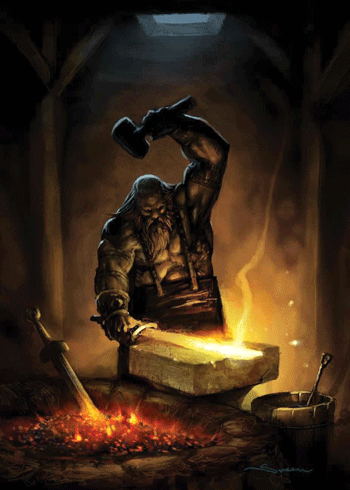
Figure 3.2 Concept art from Age of Conan.
The picture shows concept art from Funcom’s game Age of Conan – Hyborian adventures . Funcom is the dominant company in Norwegian game development. In autumn 2007, the company had 280 employees in five countries. The administration and development department is located in Oslo. Funcom focuses mainly on development of Internet-based games (MMORPG, cf. 2.3.1), but has also launched adventure games, such as Dreamfall and The Longest Journey .
Source Funcom
3.5.1 Game developers in Norway
Figures from the Norwegian game developers show that their total sales have increased by 131 per cent since 2003. In 2006, sales were in excess of NOK 100 million. As long as the Norwegian video game industry has existed, the company Funcom has dominated the market. In 2006, the company accounted for altogether 90 per cent of the total sales. Figure 3.3 illustrates these two characteristics of the Norwegian market.
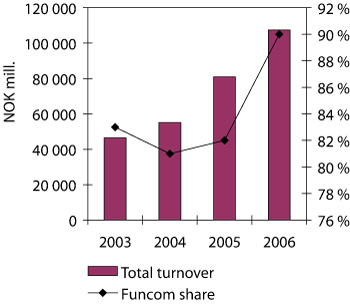
Figure 3.3 Sales by Norwegian game developers.
Source PricewaterhouseCoopers
Several of the Norwegian game developers are members of Spillprodusentforeningen [Norwegian Game Producers’ Association], which was founded in 2002. The association is an interest organization for Norwegian companies that produce video games for all formats for entertainment purposes.
Table 3.1 shows an overview of game developers that are members of the Norwegian Game Producers’ Association.
Table 3.1 Financial key figures for members of the Norwegian Game Producers’ Association
| Company | Estab-lished | Sales 2006 in NOK 1000s | Number of employees | Platform | Games (examples) |
|---|---|---|---|---|---|
| Funcom | 1993 | 96 870 | 173 | PC, online, console | Dreamfall, Age of Conan |
| Capricornus | 1999 | 4 683 | 1 | PC | Flåklypa Grand Prix (three versions) |
| Artplant | 2001 | 4 078 | 10 | PC | Captain Sabertooth, Elias |
| Skalden | 2003 | 557 | 4 | PC | Bubbins |
| Inludo Studios | 1993 | 432 | - | PC | Ragnar Rock |
| Ravn Studios | 2002 | 205 | 10 | PC, console | Englekræsj, Snakeball |
| Minimedia | 2005 | 1 006 | 2 | PC | Ungene i gata |
| Brilliantly Blond | 2006 | - | 2 | PC | Polarkameratene |
Source PricewaterhouseCoopers
The sales figures are drawn from the official accounts of the companies, and do not provide a complete picture of activities. In addition to the game development companies that are members of the Norwegian Game Producers’ Association, there are a number of companies that have games as their main business, and various small, newly started companies. The table nevertheless gives a good picture of Norwegian game developers. The company Funcom dominates both in relation to sales and the number of employees, while the other game development companies have a limited number of employees and little sales. It must however be noted that the sales figures tend to fluctuate from year to year since significant income is only generated in years when new games are launched. This applies to all of the companies. It is therefore important to build up a portfolio of titles and to develop business operations in order to ensure the stability of the companies. This can for example be done by means of various types of contract. Access to public funds will also be of major importance for the liquidity of the smaller companies.
3.5.2 Geographical distribution
The great majority of game developers are located in the Oslo area. The same applies to distributors and publishers. Geographical distribution of game developers is illustrated in figures 3.4 and 3.5.
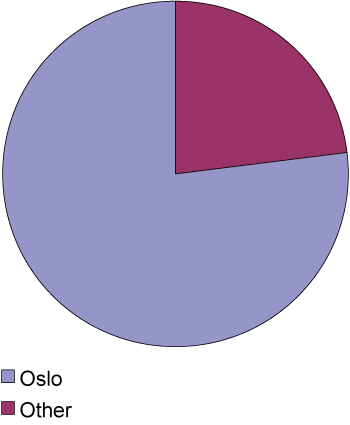
Figure 3.4 Companies in game development. Geographical distribution.
Source PricewaterhouseCoopers
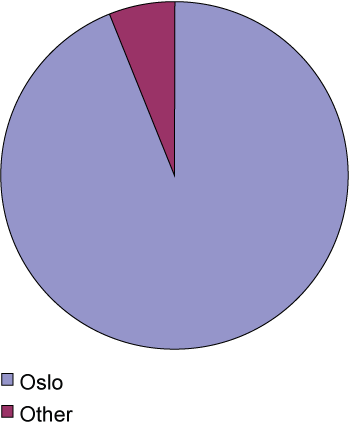
Figure 3.5 Employment in game development. Geographical distribution.
Source PricewaterhouseCoopers
The figures show that, regarding both the number of companies and the number of employees, the game development industry is concentrated in the Oslo area. The heavy dominance of this area in employment is due to the fact that Funcom is located in Oslo, cf. table 3.1.
3.5.3 Public stakeholders
Among stakeholders, there are two state-owned companies: the Norwegian Broadcasting Corporation (NRK) and Norsk Tipping AS (the Norwegian National Lottery). Neither of these two companies regards video games production as its core area, but they operate as purchasers or publishers. The Norwegian National Lottery’s game activities consist primarily of gambling games, where the participant pays a deposit and can win a money prize. Such game activities fall outside the scope of the present report.
Through its subsidiary NRK Aktivum, the NRK administers the rights to a number of content concepts. For example, a video game has been produced on the basis of NRK series such as Jul i Blåfjell and Linus i Svingen . The NRK also produces simple games for its web pages. NRK P3 in particular has used this form of alternative content on the web pages of some of its radio programmes. Most of these simple games are produced internally. When the NRK needs more advanced productions, the company purchases services from game developers.
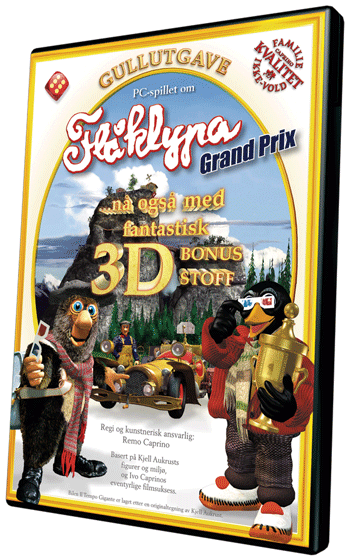
Figure 3.6 Flåklypa Grand Prix.
The game Flåklypa Grand Prix was developed by the company Capricornus, on the basis of Kjell Aukrust’s characters and the film of the same name. 270 000 copies of the game have been sold in Norway.
Source Capricornus
NRK P3 has just launched a video game portal 1 offering editorial content concerning video games. This portal may in time be further developed as a distribution channel for video games. In connection with its focus on children, the NRK uses simple video games to market various programmes. This applies mainly to licensed products from abroad (for example from the BBC), but games have also been developed on the basis of the NRK’s own productions.
3.6 The Distributor
The job of the distributor involves marketing the game, handling packaging and transport and in some cases providing user support. The international publishers sometimes function as distributors for small game developers. In such cases, the distributor owns no rights to the product, but helps in making it available on the market.
In the foreign game industry, the companies that are both publishers and developers also distribute their own games. Independent game development companies can have their games distributed by one of the large publishers/developers. Since the large companies are primarily interested in promoting their own games, it may be unfavourable for independent game companies to make such agreements. This has led to the establishment of small distribution companies, which specialize in distribution of games developed by independent game companies. Digital technology has also made it easier for developers to distribute their games via the Internet, and thereby lower the barriers for entry into this link of the value chain.
Like most other national game markets, it is the large international game companies that dominate the Norwegian distribution channels. These companies are represented through their own subsidiaries.
Other international game and machine manufacturers establish collaboration agreements of an international or regional character. For example, distribution of games and hardware in Scandinavia for Sony and Nintendo is handled, respectively, by the Danish company Nordisk Film and by the Swedish Bergsala.
There are also Nordic companies that are exclusively involved in distribution. The Danish KE Media and the Swedish Pan Vision, both of which distribute international and Nordic video games, are examples of this. The Norwegian company Norsk Spill Distribusjon AS has been established as a counterbalance to the large companies in order to promote games produced in Norway. Through the website godespill.no, they distribute the children’s games produced in Norway.
3.6.1 The sale of video games by Norwegian distributors
The Norwegian association Spill- og Multimedia Leverandørforening [Norwegian Association of Game and Multimedia Suppliers] (NSM) is a trade organization for Norwegian manufacturers and distributors of PC and console games. The association was established in 1998, and has the following members: Atari, Bergsala, Caprino Videogames, Electronic Arts, Microsoft, Nordisk Film, Ubisoft, Pan Vision, Vivendi Universal Games, KE Media and Norsk Spill Distribusjon. Since 2000, the association has compiled surveys of the wholesale sale of games by members of the association (with the exception of Microsoft, which does not release figures for its own titles). The surveys show the distribution between the various technological platforms. No surveys have been compiled of market shares distributed by country of origin, but the market share for games developed in Norway is assumed to be less than 1 per cent.
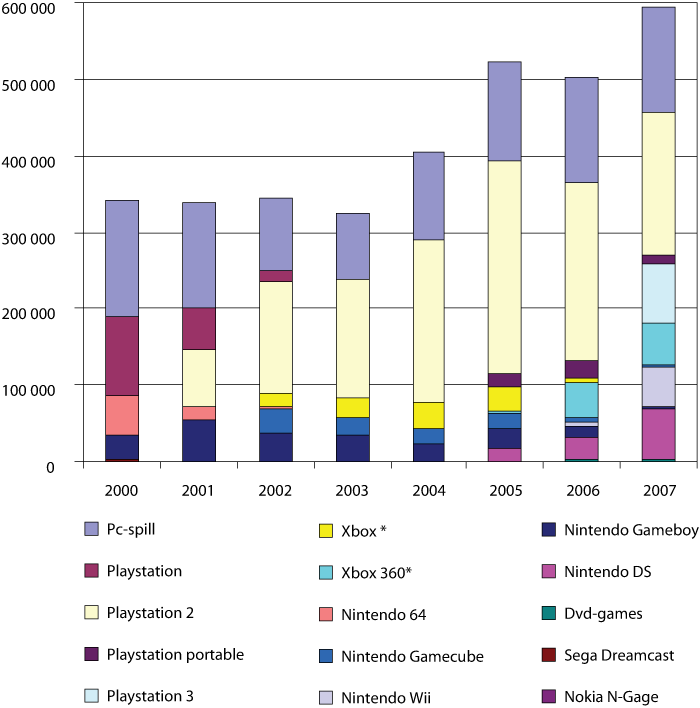
Figure 3.7 Sales by members of the Norwegian Association of Game and Multimedia Suppliers. In NOK 1000s.
* Microsoft does not release figures for its own game titles
Source Norwegian Association of Game and Multimedia Suppliers
Figure 3.7 shows that sales have almost doubled since 2000, from NOK 342.9 million in 2000 to NOK 593.8 million in 2007. Sales were fairly stable until 2003, but have shot up in recent years. This is probably associated with the introduction of new consoles. Figure 3.8 shows how the various platforms such as PlayStation, PlayStation 2 and Xbox 360 are phased in and out of the market. The market share shown for Xbox is somewhat lower than it is in reality, since Microsoft does not release figures for its own game titles for the platform. Otherwise, the figure clearly shows how new platforms capture market shares on introduction, and how older platforms are phased out. The only platform with sales throughout the whole period is PC games. The figure shows how the market share for PC games has fallen heavily. This may be due to illegal copying, which encourages more companies to focus on developing games for consoles.
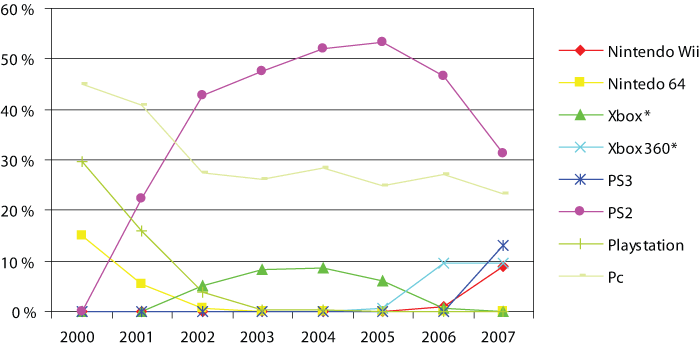
Figure 3.8 Market share of the various platforms 2000–2007.
* Microsoft does not release figures for its own game titles
Source Norwegian Association of Game and Multimedia Suppliers
An important factor in the market is the market penetration of the various platforms in units sold. Figure 3.9 shows the penetration of newer consoles in the Norwegian market, with the exception of Xbox. The figure shows that Nintendo is dominant in the market for the hand-held platform, while Sony’s PlayStation 2 dominates with considerable penetration of the console market. Microsoft’s figures are not available.
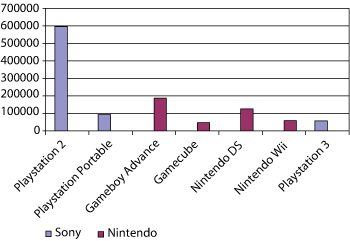
Figure 3.9 The market penetration of consoles in Norway on 30.11.2007 (number of units sold).
Source Norwegian Association of Game and Multimedia Suppliers
3.7 Sales channels
The Internet has made a number of new sales channels available. Video games can be sold via ordinary net trading, where the customer receives the game in the post or downloads it. The customer can also play games directly on the Internet, for example, in a browser (so-called browser-based games). However, most games are still sold over the counter.
It is usual to distinguish between traditional (offline) and digital (online) sales channels. Online sales channels have helped to lower the barriers for small game developers. Game developers can now distribute their games on the Internet without needing to be associated with a distributor. Although the digital technology provides opportunities for new ways of distributing games, the distribution process is nevertheless resource-demanding for small game developers. The game must be marketed, a payment solution must be chosen, the security aspects of illegal copying must be considered and, if the game is not to be sold via downloading, it must be packaged and made ready for dispatch. It is not sufficient just to make the game available on a website and expect that people will buy it.
Very few online sales channels offer digital downloading of games. The usual procedure is to provide access to ordinary net trading whereby the customer orders the goods online and receives them in the post. There are many such net shops, both Norwegian and foreign. Most chain stores also offer net trading.
The game console manufacturers provide good sales channels for game developers who have achieved a position where they can develop games for these platforms. Microsoft sells games via Xbox Arcade and Sony sells via its PlayStation Network (PlayStation Shop).
Online games have their own business model. In the case of such games, it is usual that players must pay a monthly fee to be able to play. This provides an income to the game company in addition to the income from sales of the game. Such games may also derive an income from the sale of objects that can be used in the game (these can also be sold between players) and from advertising placed in the game universe. Advertising and product placement can also be found in offline games.
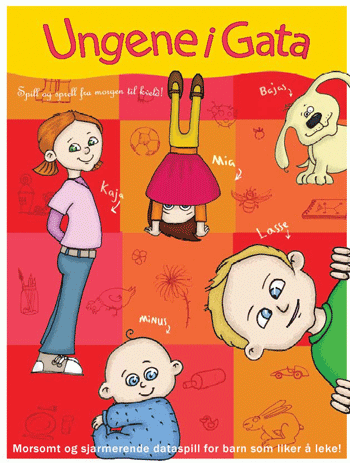
Figure 3.10 Ungene i gata.
The game Ungene i gata has been developed by the Norwegian company Minimedia. Minimedia is a typical example of small Norwegian game developers who produce simple children’s games for the PC platform.
Source Minimedia
Mobile telephone games can be sold in a number of ways. The customer can for example send a code word to a specific telephone number (code words and telephone numbers are often marketed in newspapers and weekly magazines), download the game to a PC, and then transfer it to a mobile telephone or download it directly to the mobile telephone via the telephone’s built-in browser. When the game is sold in this way, it is paid for either via the telephone bill or by credit card.
A number of websites offer free browser-based games. Examples are the Norwegian websites 1001spill.no and elitespill.com.
As mentioned above, the great majority of games are sold over the counter, i.e. through traditional sales channels. In pace with the increasing interest in video games, the interest for distributing video games has also increased. In the same way as the number of points of sale for videos of cinema films has increased enormously over the years, the availability for purchase of video games over the counter is expected to increase in future.
3.7.1 Sales channels in Norway
Traditional counter sales of games in Norway take place in three types of shop: electronics chains, multimedia shops and specialist shops. Games are also available over the counter in some supermarkets and sales outlets such as post offices. Since the large electronics chains and multimedia shops dominate the Norwegian market, distributors experience strong pressure on prices.
In recent years, business models have also been developed in Norway for the sale of games via the Internet. The Norwegian company ESP Group has focused on subscription-based game services, which they refer to as SoIP. The company holds distribution rights for over 500 game titles. The ESP Group has signed agreements with Telenor, VG, Dagbladet and RTL for supplying game services to their portals.
3.8 End users
Customers have been given a number of options as regards the various types of hardware, game products (genres and user interfaces) and availability (online and offline). The purchase of games is largely dependent on the hardware used by the end users. When end users have chosen a platform (console or hand-held) and have invested in the necessary hardware, it would involve additional cost for the user to transfer to another platform. The choice of hardware mainly depends on factors such as price, quality and available content.
Some game media are originally intended for other uses. This applies both to mobile telephones and to PCs. Some other hardware is primarily intended for video games, but has added other services, such as DVD player, connection to the Internet, etc. This applies increasingly to newer game consoles.
For more information, see the account of the use of video games in chapter 5.
3.9 Summary
In this chapter, the Ministry has provided a general introduction to the video game market by means of a brief description of the links of the value chain and the chief success factors.
The review of the value chain shows the structure of the video game industry. The range comprises large companies, which control all of the links from idea development until the game is in the homes of the end users, and an organizational network where each link consists of independent stakeholders. The increasing prevalence of online games and online distribution is influencing the structure of the value chain. For example, lower barriers to market entry are a consequence of the latter. The Norwegian game development industry is dominated by one large company: Funcom. The other companies are relatively small.
Footnotes
www.nrk.no/spiller.